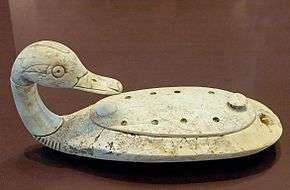Niqmaddu II
| Ugarit |
|---|
 |
| Places |
| Kings |
| Culture |
Niqmaddu II was the second ruler and king of the Ancient Syrian city of Ugarit, reigning ca. 1350-15 BC (or possibly ca. 1380-46 BC) and succeeding his father Ammishtamru I.[1][2] He took his name from the earlier Amorite ruler Niqmaddu, meaning "Addu has vindicated" to strengthen the supposed origins of his Ugaritic dynasty in the Amorites.[3]
He was a contemporary of the Egyptian ruler Amenophis IV and the Hittite ruler Shuppiluliuma I, and was a vassal of the latter.[3] He had good relations with Egypt, and conceded to the Amorites in a dispute over the Shiyannu region early in his reign.[1] He commissioned the Baal cycle about the god Haddu/Ba'al, and had a son, Niqmepa.[3]
He is identified in Syrian on an alabaster vase along with a woman in Egyptian court dress,[4] and is mentioned in the Baal cycle as King nqmd.[3] He was succeeded briefly by Ar-Halba.
References
- 1 2 Kuhrt, Amélie (1997). The ancient Near East, c. 3000-330 BC. 1. Routledge. p. 306. ISBN 0-415-16763-9.
- ↑ Feldman, Marian H. (2006). Diplomacy by design: luxury arts and an "international style" in the ancient Near East, 1400-1200 BCE. University of Chicago Press. ISBN 0-226-24044-4.
- 1 2 3 4 Smith, Mark S. (1994). The Ugaritic Baal cycle. 55. BRILL. ISBN 90-04-09995-6.
- ↑ Feldman, Marian H. (2002). "Ambiguous Identities: The -Marriage- Vase of Niqmaddu II and the Elusive Egyptian Princess". Journal of Mediterranean Archaeology. Equinox Publishing Ltd. 15 (1). ISSN 1743-1700.